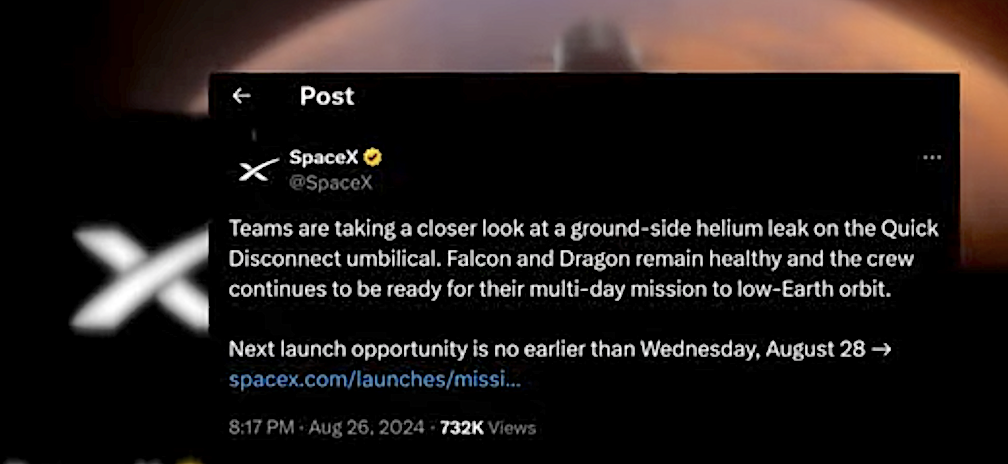
Weather still remains the reason for the SpaceX Poaris Dawn delay. Late yesterday this announcement was provided.

No further information has been provided by SpaceX regarding the upcoming Polaris Dawn launch of astronauts. The launch will take a New Hampshire man and three other crew members higher up than anyone has been since the Apollo moon missions.
UPDATE: SpaceX now is standing down and delays launch of Polaris Dawn’s first commercial space walk due to weather

Due to unfavorable weather forecasted in Dragon’s splashdown areas off the coast of Florida, SpaceX is standing down from Falcon 9’s launch opportunities of Polaris Dawn on Wednesday, August 28 and Thursday, August 29. SpaceX teams will continue to monitor weather for favorable launch and return conditions.
Earlier on Tuesday SpaceX issued a launch date Wednesday, August 28 at 3:38 a.m. ET for Falcon 9’s launch of Polaris Dawn to low-Earth orbit from Launch Complex 39A at NASA’s Kennedy Space Center in Florida. The launch was delayed 24 hours from the planned pre-dawn Tuesday blast-off due to a ground-side helium leak on the Quick Disconnect umbilical, SpaceX said.
Umbilical systems employ fluid connectors known as quick disconnects to transfer fluids into a vehicle, according to NASA. During their multi-day mission to orbit, Dragon and the crew will endeavor to reach the highest Earth orbit ever flown since the Apollo program and participate in the first-ever extravehicular activity (EVA) by commercial astronauts wearing SpaceX-developed EVA suits.

There are two additional launch opportunities within the four-hour window at 5:23 a.m. ET and 7:09 a.m. ET. If needed, backup opportunities are available on Thursday, August 29 at the same times.
Supporting the crew throughout the spacewalk will be SpaceX’s newly-developed EVA suit, an evolution of the Intravehicular Activity (IVA) suit crews currently wear aboard Dragon human spaceflight missions. Developed with mobility in mind, SpaceX teams incorporated new materials, fabrication processes, and novel joint designs to provide greater flexibility to astronauts in pressurized scenarios while retaining comfort for unpressurized scenarios.
The 3D-printed helmet incorporates a new visor to reduce glare during the EVA in addition to the new Heads-Up Display (HUD) and camera that provide information on the suit’s pressure, temperature, and relative humidity. The suit also incorporates enhancements for reliability and redundancy during a spacewalk, adding seals and pressure valves to help ensure the suit remains pressurized and the crew remains safe.

All of these enhancements to the EVA suit are part of a scalable design, allowing teams to produce and scale to different body types as SpaceX seeks to create greater accessibility to space for all of humanity.

While Polaris Dawn will be the first time the SpaceX EVA suit is used in low-Earth orbit, the suit’s ultimate destiny lies much farther from our home planet. Building a base on the Moon and a city on Mars will require the development of a scalable design for the millions of spacesuits required to help make life multiplanetary.
A live webcast of this mission will begin about 3.5 hours prior to liftoff, which you can watch here and on X @SpaceX.
The Dragon spacecraft supporting this mission previously flew Crew-1 to and from the International Space Station, and Inspiration4, the first all-civilian mission to orbit. This will be the fourth flight for the first stage booster supporting this mission, which previously launched Crew-8 and two Starlink missions. Following stage separation, Falcon 9’s first stage will land on the A Shortfall of Gravitas droneship stationed in the Atlantic Ocean.
